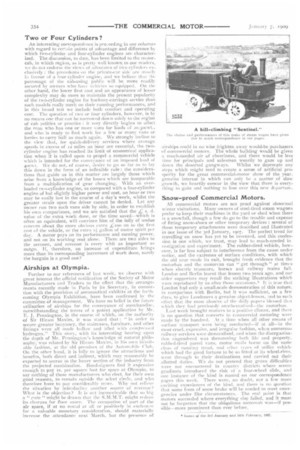Two or Four Cylinders ?
Page 2

If you've noticed an error in this article please click here to report it so we can fix it.
An interesting correspondence is pro:.eeding in our t.-oluions with regard to certain points of advantage and difference bv which two-cylinder and four-cylinder engines are character ised. The discussion, to date, has been limited to the motorcab, in which region, as is pretty well known to our readers, WC do not endorse the views of advocates of two cylinders ex clusively : the precedents on the private-car side are moacly in favour of a four cylinder engine, and we believe that the
patronage of the cab-using public will be more readily secured by owners who have vehicles so equipped. On the other hand, the lower first cost and an appearance of lesser complexity may do more to maintain the present popularity of the two-cylinder engine for hackney-carriage service than such models really merit on their running performances, and in this broad test we include both comfort and operating cost. The question of two or four cylinders, however, is by no means one that can be narrowed down solely to the region of cab politics or practice : it very directly begins to affect the man who has one or more vans for loads of 2o-3ocwt., and who is ready to find work for a few or many vans or lorries to carry half as much again. We strongly incline to the view that, for quick-delivery services where average speeds in excess of 12 miles an hour are essential, the twocylinder engine has. reached its limit of economical application when it is called upon to propel a commercial vehicle which is intended for the conveyance of an imposed load of aocwo We do not, of course, desire to go so far as to lay this down in the form of an inflexible rule : the considerations that guide us in this matter are largely those which arise front a knowledge of the losses which are inseparable from a multiplication of gear changing. With an overloaded two-cylinder engine, as compared with a four-cylinder engine of but slightly higher power and cost, an hour or two may be easily lost in the course of a day's work, whilst the greater strain upon the driver cannot be denied. Let any owner run two such vans side by side, in order to establish his own comparisons, and we are satisfied that the L s, d. value of the extra work done, or the time saved—which is often an equivalent, will convince him of the folly of undue concern about the more obvious extra L:too on to the first cost of the vehicle, or the extra qi gallon of motor spirit per day. A motor pays on its performance and earning power, and not on its working cost alone. There are two sides to the account, and revenue is every whit as important as outgo. I f, therefore, an increase of expenditure brings more than its corresponding increment of work done, surely the bargain is a good one?
























